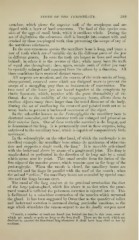Page 379 - My FlipBook
P. 379
TEETH OF THE VERTEBRATA. 389
vertebrae, which pierce the superior wall of the oesophagus and are
tipped with a layer of hard ceiiieutuni. The food of this species con-
sists of the eggs of small birds, wliicli it swallows whole. During the
act of deolutition the calcareous shell is brouo-ht into contact with and
crushed by these oesophageal teeth, thus preventing the escape of any of
the nutritious substances.
In the non-venomous species the maxillary bone is long, and bears a
row of teeth which are of variable size in the ditJerent parts of the jaw
in different genera. In some the teeth are largest in front and smallest
behind ; in others it is the reverse of this ; while many have the teeth
of equal size throughout ; then, again, certain teeth of either jaw may
be specially enlarged and separated from the others by a diastema. All
these conditions have received distinct names.
All serpents are acrodont, and the crowns of the teeth consist of long,
sharp-pointed, recurved cones which are designed more to prevent the
escape of a struggling prey than as instruments of mastication. The
two rami of the lower jaw are bound together at the symphysis by
elastic ligaments, which, together with the great distensibility of the
throat, due to the mobility of the suspensory bones, allows them to
swallow objects many times larger than the usual diameter of the body.
During the act of swallowing the recurved and pointed leeth act as so
many hooks to prevent a backward movement of the object.
In the sub-order known as the Proferoglyph'ut the maxillary bone is
shortened somewhat, and the anterior teeth are enlarged and grooved on
their anterior faces. One of these teeth (the anterior) is the largest, and
is denominated the fang. It is permanently erect in these serpents, being
ankylosed to the maxillary bone, which is capable of comparatively little
movement.
In the solenoglyplis, on the other hand, of which the rattlesnake is an
excellent example, the maxillary bone attains its maximum of abbrevia-
tion and supports a single tooth, the fang.^ It is movably articulated
with the lachrymal above by means of a ginglymoid joint. The fang is
canaliculated or perforated in tlie direction of its long axis by a canal
which opens near its point. This canal results from the fusion of the
free edges of the anterior groove, which remains open in the fangs of the
proteroglyphs. When the mouth is closed, the maxillary bones are
retracted and the fangs lie parallel with the roof of the mouth ; when
the animal " strikes," the maxillary bones are extended by special mus-
cles and the fangs become erect.
The canal of the fang receives at its proximal termination the duct
of the large poison-gland, which lies above it, so that when the punc-
tured wound is inflicted the poisonous secretion is injected into it. This
is facilitated by a coincident contraction of the muscles which surround
the gland. It has been suggested by Owen that as the quantity of saliva
and lachrymal secretion is increased during particular emotions, so the
rage which stimulates the venom-serpent to use its deadly weapon must
' Usually, a number of teeth are found just })ehind the fang in this bone, some of
which are nearly or quite as large as the fang itself. These are the teeth which are
destined to succeed the functional fang whenever it shall have been shed or lost by
accident.


